FEATool 1.7 Multi-Simulation
With the release of FEATool 1.7 Precise Simulation Ltd. is taking a step beyond Multiphysics by introducing the modeling and simulation tool concept Multi-Simulation. The goal of Multi-Simulation is to allow for seamless switching between both built-in and external solvers and simulation tools. Beginning with FEATool 1.7, Multi-Simulation supports the FEniCS multiphysics and CFD solvers, and the postprocessing and visualization tool Plotly. This functionality is available with both easy to use one-click buttons directly in the FEATool GUI, as well as with MATLAB m-file scripting.
In addition to Multi-Simulation, FEATool 1.7 also features significant updates and new physics modes for porous media flows, structural mechanics, electrostatics, and magnetostatics. Moreover, all applicable physics modes have been updated to support axisymmetric cylindrical coordinate systems with corresponding GUI support. Furthermore, FEATool now also supports solving different equations in different coupled geometrical subdomains, for example allowing for fluid-structure interaction simulations.
New Physics Modes
The following five new PDE physics modes have been implemented and added for modeling and simulation of porous media flow, electromagnetics, and one-dimensional stress-strain beam theory
The new physics modes are available to use with both the FEATool GUI and on the command line for relevant space dimensions.
Predefined Axisymmetric Physics Modes

In addition to the new physics modes, the following physics modes have also extended to support axisymmetric cylindrical coordinate systems (pseudo 3D)
- Axisymmetric Stress-Strain
- Conductive Media DC
- Convection and Diffusion
- Heat Transfer
- Navier-Stokes Equations
- Poisson Equation
Axisymmetric multiphysics modeling can now be selected and enabled directly in the FEATool GUI by choosing the new Axi 2D option as Space Dimension in the the New Model dialog box.
Partial Activation of Subdomains and Equations
Support for activating/de-activating equations and dependent variables in different subdomains is now also possible. By using the new Active toggle button in the Subdomain Settings dialog box of each physics mode the equations and dependent variables can be turned on and off for each distinct subdomain. Using this feature also activates internal boundaries which become available to assign boundary conditions to.
The practical implications of this new feature is that different equations and physical phenomena can now be modeled and solved for in different subdomains and geometric regions. Moreover, one can easily couple different variables and physics through the internal boundaries. Fluid-structure interaction is for example one application where this functionality is necessary, modeling fluid in one region, stresses, strains, and displacements in the other, and coupling the stresses along the interfacing boundary.
External FEniCS Solver Support

With the Multi-Simulation concept the FEniCS C++ and Python general FEM solution toolkit has also been interfaced with FEATool. The FEATool GUI now features an integrated one-click button and corresponding MATLAB CLI functions to export and convert multiphysics grids and models to FEniCS format, and optionally use FEniCS to solve the problem (if installed and available). In contrast to the built-in direct solvers, using FEniCS potentially allows for distributed parallel HPC solvers capable of efficiently handling very large scale problem sizes.
Full Plotly Integration

Plotly is a javascript visualization and plotting library that now also is fully integrated with FEATool and can be used to visualize FEM simulation results and data. Plotly plots are stand-alone html web pages that can be inspected, rotated, zoomed, and exported as image and svg files with the following benefits
- fully self-contained and interactive web graphics pages
- high performance plots with further export functionality
- share with coworkers and colleagues through cloud and web services
Try out Plotly by simply using the Plotly button in the Postprocessing Mode of the FEATool GUI.
Other New Features
- New models and examples
- Support for 2nd order derivatives and equation definitions
- Parsing of groups of derivatives in parentheses
- Support arbitrary order quadrature rules for all grid cell types
- Easy Windows installation packages
- Fixes and improvements
